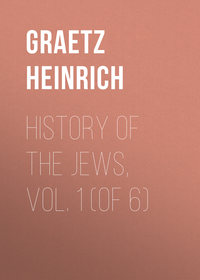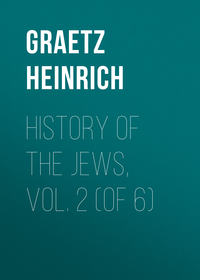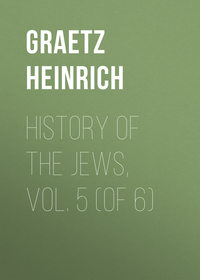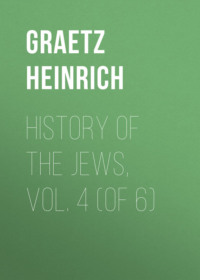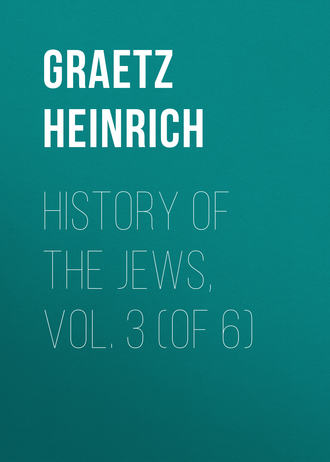
History of the Jews, Vol. 3 (of 6)
When Joseph wrote this letter, he could boast of the peaceful state of his kingdom. But circumstances changed in the course of a few years. One of Rurik's descendants, the Russian Prince Sviatislav of Kief, formerly almost a subject of the Chazars, made a formidable attack upon the country, and captured the fortress of Sarkel (965). The conqueror grew more powerful, and, a few years later, in 969, the same Sviatislav took the capital, Itil (Atel), and also captured Semender, the second town of the Chazars. The Chazars took to flight, some going to an island in the Caspian Sea, others to Derbend, and yet others to the Crimea, in which many members of the same race lived, and which henceforth received the name of "the Land of the Chazars." Its capital was Bosporus (Kertch). Thus did the kingdom of the Chazars decline, and Joseph was its last king who possessed any power. When Chasdaï received his letter, his patron, Abdul-Rahman, had died. His son Alhakem, a more zealous patron of science and poetry even than his father, now sat upon the throne. More peacefully disposed than his father, he honored Chasdaï, whom he made an important state official, and whose superior talents he employed as freely as his father had done.
Imitating the example of two Caliphs, who respected genius, Chasdaï protected the Jews, and to him is credit due for having given the impulse to the Jewish-Andalusian culture. He gathered around him at Cordova a band of talented philosophers and poets, who in turn immortalized him in their works and poems. "In Spain far and wide, wisdom was cherished in Chasdaï's time. His praise was sung by eloquent tongues." Only two of the philosophers and poets of this time became famous, Menachem ben Saruk and Dunash ben Labrat. Both of these made the Hebrew language, which they considerably enriched, the object of deep research. They went far beyond all their predecessors that had worked at philology, the Karaites and even Saadiah.
Dunash ben Labrat in his works developed a symmetry and harmony of expression in the holy language such as was scarcely conceivable by his predecessors. He was the first to employ meter in Hebrew poesy, which he made melodious through the introduction of the strophe. Dunash was blamed by Saadiah for this as though he had made an unheard-of innovation. Saadiah thought that violence was done to the Hebrew language thereby. However, the new Hebrew poetry was enriched through the efforts of the Jewish-Andalusian writers. Hitherto, poetical compositions had been of a synagogal character, always gloomy, and never assuming a joyful tone. Even hymnal poetry was not devoid of this characteristic, and continued halting and rugged like Kaliri's. In didactic and controversial poems a miserable doggerel was used, as in the verses of Solomon ben Yerucham, of Abu-Ali Jephet, of Ben-Asher and Sabbataï Donnolo. Chasdaï, however, gave the poets an opportunity of changing their subjects. His imposing person, his high position, his deeds, and his princely liberality had an inspiring influence upon the poets, and whilst they sang his praises in animated strains, they breathed new life into the apparently dead Hebrew language, rendering it harmonious and capable of development. Of course, the Jewish-Andalusian poets took the Arabs as their model. They in truth do not deny that "Arab became the teacher of Eber." But Dunash and others, who imitated him, did not slavishly adhere to their Arab pattern, nor adopt its unnatural meter, but they selected its beauties and imitated them. The verses at the beginning of this flourishing period of poetry were brisk and lively in their measure, and yet the Hebrew poetry of the epoch of Chasdaï did not entirely cast off its fetters, nor change its high-flown style. "The poets in Chasdaï's time first began to chirp," as the inimitable critic of a later time remarks. The favorite themes of the new Hebrew poesy now became panegyric and satire, but it did not lose sight of liturgical poetry, which it also adorned with the beauty of meter.
Little is known of the life and character of the first two founders of the Andalusian-Jewish culture. As far as can be gathered from existing sources, Menachem ben Saruk, of Tortosa (born 910, died 970), was in needy circumstances from his earliest years; at any rate, his patrimony was too small to maintain him. Chasdaï's father Isaac was interested in him, and took care that pecuniary difficulties should not destroy the germ of poetry which was latent in him. His favorite occupation was the study of the Hebrew language; he made use of the works of his predecessors, but he did not acquire his noble Hebrew style from them – that was inborn.
When Chasdaï attained his high position, he invited the favorite of his father, with flattering words and glowing promises, to come to Cordova. Menachem became Chasdaï's court poet, and was warmly attached to him, praising him in every kind of verse, and, as he himself affirms, "exhausted poetry in singing Chasdaï's praises." Chasdaï encouraged him to write on the philology of the Hebrew language, and to endeavor to ascertain its various forms, and to investigate the meanings of words. Menachem in consequence wrote a complete Hebrew dictionary (Machbereth), with some grammatical rules, in which he corrected his predecessors in many respects. Brought up amidst surroundings by which harmonious and impressive speech was prized, the grammarian of Tortosa valued language in general very highly, and the Hebrew language in particular, and it was the aim of his work to discover the peculiar refinements of this language. Menachem ben Saruk was the first to distinguish clearly the pure roots in the Hebrew language, and to separate them from the formative prefixes and suffixes – a theory which now appeared for the first time, and which had been misapprehended by previous grammarians. This misapprehension, indeed, had led them into using malformed and ill-sounding words in their verses. Menachem, in his lexicographical work, puts the various forms under each root, and often expounds their meanings with surprising clearness and nicety. In cases where he gives a peculiar explanation according to his understanding of the Biblical verse, he often shows healthy thought and refined taste, and there is a marked step forward in exegesis from Saadiah to Menachem. Now and again he gave explanations which were opposed to Talmudic tradition and the ideas of the time. His lexicographical work was much read and used, because it was written in Hebrew. It found its way into France and Italy, supplanted the works of Saadiah and the Karaites, and, for a long time, was the guide-book for Bible expositors. But grand and flowing as Menachem's Hebrew prose is, his verse is unattractive and awkward; he did not understand how to handle Hebrew meter. He was, however, supplemented by his rival, Dunash ben Labrat.
This poet (also called Adonim) came from Bagdad, and was younger than Menachem (born 920, died 970). He afterwards lived in Fez, and was likewise invited to Cordova by Chasdaï. Dunash appears to have been wealthy, and was thus able to be freer and more independent than the grammarian of Tortosa. He was a man of spirited and reckless disposition, who did not weigh his words, and was well qualified for literary controversy. He, too, possessed a deep knowledge of the Hebrew language, and was a far more successful poet than Menachem. As has been mentioned, he was the first of the Rabbanite circle in Spain to introduce meter into the new Hebrew poetry, to which he thereby gave a fresh charm. He was, however, bold and venturesome. He criticised Saadiah's exegetical and grammatical works in a polemic (Teshuboth), assuming rather a harsh tone, although he was personally acquainted with the author, and was perhaps his pupil. As soon as Menachem's dictionary reached him, Dunash determined to write an unsparing criticism of it, and to bring its mistakes to light. His review was witty but scornful. Dunash did not keep within the limits of scientific discussion, but used it to promote his own interests. He dedicated his critical works against Menachem to the Jewish statesman, whom he flattered so abjectly in some prefatory verses, that we can hardly fail to see that his object was to gain over the Jewish Mæcenas to his side, and to injure Menachem in the eyes of the latter.
Dunash's flattery of the Jewish statesman and his coarse polemic against Menachem are not wanting in power. The admiration of Chasdaï for Ben-Saruk was diminished when he perceived that Dunash was a better poet, and at least as good a philologist. When various calumniators who wished to ingratiate themselves with the Jewish prince, traduced Menachem before him, Chasdaï's favor was withdrawn from the latter, and changed into direct hostility. In what their defamations consisted is not known.
Menachem appears to have died before his rival Dunash, and his pupils undertook to justify him. Jehuda ben Daud, Isaac Ibn G'ikatilia, and Ben-Kafren (Ephraim) were the most important of these. They, too, dedicated their polemical writings to the Jewish minister, and sent him a panegyric and a satire against Dunash. Chasdaï seems to have just returned from a diplomatic victory which he had won for the Caliph Alhakem. The followers of Menachem celebrated his triumph: "The mountains greet the protector of learning, the prince of Judah. All the world rejoices at his return, for whenever he is absent, darkness sets in, the haughty rule and fall upon Judah's sons. But Chasdaï brings back peace and order. God has appointed him prince, and granted him the king's favor, whereby He exalted him above all the nobles."
Menachem's defenders endeavored to appeal to Chasdaï's love of truth, and to make him the arbiter against Dunash, "who set himself up as the chief of commentators, who knows neither law nor limit of change, and who desecrates and spoils the holy language through his foreign meter." The study of the Hebrew language was carried on in Spain by means of severe contention and virulent satire. The pupils of Dunash continued the quarrel. The followers of Menachem and Dunash hurled witty lampoons against each other, which fact contributed largely towards making the Hebrew language at once pliant and rich.
As Chasdaï Ibn-Shaprut had given an impulse to various poets and writers by means of encouragements and rewards, so also he founded a home in Spain for the study of the Talmud. Jewish science in Europe had not yet attained a sufficiently firm footing to enable it to dispense with the fostering care of a protector. Moses ben Chanoch, too, who had been chosen to collect contributions for the school of Sora, and who had been brought as a slave to Cordova and there redeemed, found a patron in Chasdaï, and the two Caliphs who were friendly to science beheld with pleasure the study of the Talmud springing up in their realms, because it would tend to sever their Jewish subjects from the Caliphate of Bagdad. Moses could have come to Spain at no more favorable time for establishing firmly the study of the Talmud, without which the literary activity just springing up could not have made progress. Just as the Spanish Moors had busied themselves with the task of casting the Caliphate of Bagdad into the shade, in the hope of monopolizing all political and literary distinctions, so the Spanish Jews longed to obscure the Babylonian schools, and to transfer to the school which Moses had opened in Cordova the supremacy which the former had hitherto enjoyed, owing to the deeper knowledge of the Talmud there.
They consequently treated Moses with great deference, surrounded him with splendor, and recognized him as their head. Religious questions which had hitherto been sent to the Babylonian schools, henceforth were directed to Moses. From all parts of Africa, eager students flocked to his school. There now arose a strong desire for thorough Talmudical knowledge, which would enable them to dispense with the Babylonian teachers. Chasdaï gave orders for copies of the Talmud to be bought at his expense in Sora, where many lay idle and unused. These he distributed amongst the pupils, whom he doubtless furnished with means of subsistence. Thus Cordova became the Andalusian Sora, and the founder of the school there had the same significance for Spain as Rab had for Babylon. Although he bore the modest title of judge (Dayan), he yet performed the various functions of a Gaon. He ordained rabbis for the various communities, as it appears, by the ceremony of laying on the hands (Semicha); he expounded the Law, the highest appeal was made to him in legal cases, and he could excommunicate rebellious members of the community. All these functions devolved upon the rabbis in later times.
Thus Spain became in many ways the center of Judaism. Several apparently accidental events contributed to this result, and the aroused self-importance of the Spanish Jews did not allow this supremacy to depart from their midst; in fact, they took the greatest pains to assert and to deserve it. The prosperity of the Cordova Jewish community made it possible for them to make the Andalusian capital the center of all undertakings. Cordova numbered several thousand rich families, well able to vie with the Arabs in display. They clothed themselves in silk, wore costly turbans, and drove in splendid carriages. They rode on horses, and adopted the manners of chivalrous society, which distinguished them from the Jews of other lands. It cannot be denied, however, that some of them owed their wealth to their trade in Slavonian slaves. These they sold to the Caliphs, who gradually formed their body-guard from them.
After Moses' death (965) the community of Cordova was threatened with a division on account of the succession. On the one side was Moses' son Chanoch, who, when a child, had shared his parent's captivity, and had seen his mother throw herself into the sea. His rival was Joseph ben Isaac Ibn-Abitur, who was the distinguished pupil of Moses. He possessed sound knowledge of Arabic literature, was a tolerable poet, and a native of Spain. But Chanoch possessed no attainments except knowledge of the Talmud, and the advantage of being the son of a man who had been highly esteemed.
The two rivals were equally distinguished for their piety and their character. There were consequently two parties – the one siding with the native, who was the representative of culture, the other with Moses' son. Meanwhile, before the strife had taken a serious turn, Chasdaï exerted his powerful influence in favor of Chanoch. The latter thus became rabbi of Cordova and the authority for the Jewish-Spanish communities. As long as the Jewish minister of Alhakem lived, Chanoch's right to the rabbinate remained unchallenged. Chasdaï Ibn-Shaprut died during the lifetime of the noble Caliph (970), and left behind him an illustrious name, and both Jews and Mahometans vied with each other in perpetuating it for posterity.
CHAPTER VIII.
THE RISE OF JEWISH-SPANISH CULTURE, AND THE DECAY OF THE GAONATE
The Gaon Sherira and his son Haï – Sherira's Historical Letter – The Jewish Congregations in Spain – Jewish Culture in Andalusia – The Disciples of Menachem and Dunash – Jehuda Chayuj – Contest between Chanoch and Ibn Abitur – Jacob Ibn Jau – The Jews of France – Nathan the Babylonian and Leontin – The Jews of Germany – Gershom and his Ordinances – The Emperor Henry II. – The Caliph Hakem – The Jewish Communities of Northern Africa – Chananel, the Son of Chushiel, and Nissim bar Jacob Ibn-Shahin – The Jerusalem Talmud – Haï Gaon – His Character and Importance – Samuel bar Chofni – Chiskiya, the last Gaon – Samuel Ibn-Nagrela – Jonah Ibn-Janach.
970–105 °C. EWhen an institution of historic origin is doomed to sink into oblivion, the most strenuous exertions of men cannot save it; and though they succeed by generous sacrifices in deferring the time of its extinction, its continuance is at best like that of a man in a trance.
So it happened to the Babylonian Gaonate, once so full of life. After the most cultured communities of Spain and Africa had withdrawn their support, and had made themselves independent of it, its fate was sealed. It was in vain that the two men who successively adorned the school of Pumbeditha by their virtue and knowledge, made a strenuous effort to give it new life. They only succeeded in staying the death of the Gaonate for somewhat more than half a century, but they were unable to restore its vitality. These two men – father and son, the last distinguished presidents of the school of Pumbeditha – were Sherira and Haï (Haaja), to whom later generations gave the name of "the fathers and teachers of Israel."
Sherira, son of the Gaon Chanina (born 920, died 1000), was of distinguished parentage both on his father's and his mother's side, several members of both families having filled the office of Gaon. He boasted that he could trace his descent to the line of the Exilarchs before Bostanaï. The seal of the Sherira family bore the impress of a lion, which is said to have been the coat-of-arms of the Jewish kings.
Sherira was a Gaon of the old school, who valued the Talmud above everything, and steered clear of philosophical ideas. He was sufficiently acquainted with the Arabic language to use it in answering questions which were directed to him by the Jewish communities in Moslem countries. He preferred, however, to make use of the Hebrew and Chaldee languages, and had no taste for Arabic literature. His literary activity was entirely devoted to the Talmud and cognate subjects. He did not trouble himself much about Biblical exegesis, but his moral earnestness makes us overlook his lack of higher culture. As a judge, he always endeavored to elicit the truth and to decide accordingly. As head of the school, he spared no pains to spread instruction far and near, hence his decisions are voluminous. But Sherira kept most conscientiously to Talmudic precedents in framing his decisions; and on one occasion severely criticised a master who taught his young slave the Bible, and when he had grown up, allowed him to contract an illegal marriage with another slave, because this was contrary to the decision of several Talmudical teachers. Sherira was versed in theosophy, which had but few followers at his time.
Sherira is especially distinguished on account of his "Letter," which is the main authority for the history of the Talmudical, post-Talmudical, and Gaonic periods of Jewish history. Jacob ben Nissim (Ibn-Shahin), a pupil of the Chushiel who had been taken captive to Africa, and who taught the Talmud in Kairuan, sent a letter of inquiry in the name of the community of Kairuan to Sherira. In it the following questions were propounded: "In what way was the Mishna written down? If the traditional law is of remote origin, how does it happen that only authorities of a comparatively recent period are known to us as bearers of the same? In what order were the various books of the Mishna compiled?" Jacob also asked about the order of the Saboraim and the Geonim, and about their respective terms of office. Sherira wrote an answer (987) half in Hebrew and half in Chaldee, in which he threw light upon several dark portions of Jewish history. The chronicle of the Saboraim and Geonim as given by him is our guide for this epoch. Sherira in this "Letter" answers the questions put to him with the simple straightforwardness of the chronicler. But his opinions about the Exilarchs of the line of Bostanaï, and about some of his contemporaries, e. g., about Aaron Ibn-Sarjadu, are not altogether unbiased. We have to thank the Gaon Sherira for the preservation of the facts of Jewish history from the period of the conclusion of the Talmud till his own time. It was not in his power to produce an historical work of a critical character, nor, indeed, was this possible for the genius of the Middle Ages.
In spite of his incessant activity as head of the school, he was unable to prevent the decay of the school of Pumbeditha. The zeal for the study of the Talmud and scientific activity had cooled in the Babylonian countries. The academy had so few scholars at this time that Sherira was compelled to promote his young son Haï, when only sixteen years old, to the high office of chief judge. The respect for the Gaon had vanished. Malicious persons had Sherira arraigned before the Caliph Alkadir on some unknown charge, probably growing out of the rigor of his administration (997). In consequence of this, father and son were deprived of their liberty, all their property was confiscated, and there was not enough left to them for a bare livelihood. They were, however, liberated at the intercession of an influential man, and restored to their dignity. Sherira soon after, on account of old age, abdicated in favor of his son (998), and died a few years later.
His son Haï, although he was only 30 years old, was so popular that to the reading of the Law on Sabbath, as a mark of honor to him, the portion of the Pentateuch was added in which Moses prays for a worthy successor, and instead of the usual prophetic lesson, the story of David anointing his successor was read, and in conclusion the words, "And Haï sat on the throne of Sherira his father, and his kingdom was firmly established."
We turn gladly from the decay of the internal organization of the Jews in the East to the vitality of the communities on the Guadalquiver and the Guadiana. Vigorous forces and spiritual currents of most varied character asserted themselves everywhere, and produced the brilliant efflorescence of Jewish culture. There arose in the Jewish communities of Andalusia intense zeal for the various branches of knowledge, and an eager desire for creative activity.
The seed which had been sown by Chasdaï, the Jewish Mæcenas, by the study of the Talmud under Moses the Babylonian, and by the poetical and philological works of Menachem and Dunash, produced the fairest fruit. Many-sided knowledge was considered among the Spanish Jews, as well as among the Andalusian Moslems, a man's most beautiful ornament, and brought its possessor honor and riches. Following the example of Abdul-Rahman the Great, the Moslems admitted Jews to state offices, owing to their superior insight and business capacity; thus we find both Jewish consuls and Jewish ministers at Mahometan and Christian courts. These emulated the conduct of Chasdaï in encouraging learning and poetry. The knowledge of the period was neither one-sided nor barren; on the contrary, it was full of healthy life, useful and productive. The cultured Jews of Andalusia spoke and wrote the language of the country as fluently as their Arab fellow-citizens, who were as proud of the Jewish poets as the Jews themselves.
The Andalusian Jews were equally active in Bible exegesis and grammar, in the study of the Talmud, in philosophy and in poetry. But the students in any one of these departments were not narrow specialists. Those who studied the Talmud were indifferent neither to Biblical lore nor to poetry, and if not poets themselves, they found pleasure in the rhythmic compositions of the new Hebrew poesy. The philosophers strove to become thoroughly versed in the Talmud, and in many instances rabbis were at the same time teachers of philosophy.
Nor were science and art looked upon by the Spanish Jews as mere ornaments, but they exalted and ennobled their lives. Many of them were filled with that enthusiasm and ideality which does not allow the approach of any kind of meanness. The prominent men, who, either through their political position or their merits stood at the head of Jewish affairs in Spain, were for the most part noble characters imbued with the highest sentiments. They were as chivalrous as the Andalusian Arabs, and excelled them in magnanimity, a characteristic which they retained long after the Arabs had become degenerate. Like their neighbors, they had a keen appreciation of their own value, which showed itself in a long string of names, but this self-consciousness rested on a firm moral basis. They took great pride in their ancestry, and certain families, as those of Ibn-Ezra, Alfachar, Alnakvah, Ibn-Falyaj, Ibn-Giat, Benveniste, Ibn-Migash, Abulafia, and others formed the nobility. They did not use their birth as a means to obtain privileges, but saw therein an obligation to excel in knowledge and nobility, so as to be worthy of their ancestors. The height of culture which the nations of modern times are striving to attain, was reached by the Jews of Spain in their most flourishing period. Their religious life was elevated and idealized through this higher culture. They loved their religion with all the fervor of conviction and enthusiasm. Every ordinance of Judaism, as prescribed in the Bible and as explained in the Talmud, was considered holy and inviolable by them; but they were equally opposed to stolid bigotry and to senseless mysticism. Although they often carried their investigation to the borders of unbelief, yet there is scarcely one of the Jewish-Spanish thinkers who crossed these bounds, nor did extravagant mysticism find favor with them during the flourishing period. No wonder, then, that the Jews of Spain were looked upon as superior beings by their uncultured brethren in other lands – in France, Germany, and Italy – and that they gladly yielded them the precedence which had formerly been enjoyed by the Babylonian academies. Cordova, Lucena, and Granada soon took the place of Sora and Pumbeditha. The official chief of the Jews in Andalusia was Chanoch, of whom we have already spoken (940–1014). He succeeded his father in the rabbinate. His rival, Joseph ben Isaac Ibn-Abitur (Ibn-Satanas or Santas), a member of a respected Andalusian family, was as learned in the Talmud, and excelled him in the extent of his secular knowledge. Ibn-Abitur wrote in verse. Among other things he composed synagogue poetry for the Day of Atonement, but his verse is harsh, awkward, and altogether devoid of poetic charm. He had not profited by the poetry of Dunash. Joseph Ibn-Abitur understood the Arabic language so well that he was able to translate the Mishna into that language. The Caliph Alhakem had expressed a wish to possess a translation of the work containing the sources of Jewish tradition, and Ibn-Abitur gratified that wish to his satisfaction. The refined Caliph probably only desired to increase his library (which was of such proportions that the catalogue took up twenty-four volumes) by the addition of the Mishna, which was so highly valued by the Jews. The men most distinguished in philology and Hebrew poetry during the period after Chasdaï were the pupils of Menachem and Dunash. They carried on a controversy in epigrams, in prose and verse. Of these, Isaac Ibn-G'ikatilia was a poet, and Jehuda Ibn-Daud a Hebrew grammarian. The latter, whose Arabic name was Ibn-Zachariah Yachya Chayuj, descended from a family which came from Fez, was the first to place Hebrew philology on a firm basis, and may be regarded as the first scientific grammarian. Chayuj, too, was the first to recognize that Biblical Hebrew roots consist of three letters, and that several consonants (the liquids, semi-vowels, and the sounds produced by the same organ) become assimilated and change into vowels. He thereby made it possible to know the different forms and their changes, and to apply this knowledge to poetry. Chayuj thus brought about a complete reform in the Hebrew language, and illumined the darkness wherein his predecessors, amongst them Saadiah, Menachem, and Dunash, and to a greater extent the Karaites, had been lost. Chayuj wrote his grammatical works in Arabic; on this account they remained unknown to the Jews out of Spain, who retained the imperfect systems of Menachem and Dunash in their philological studies.


